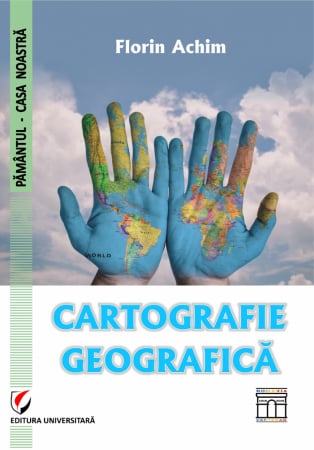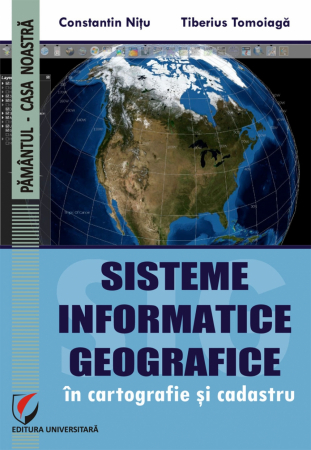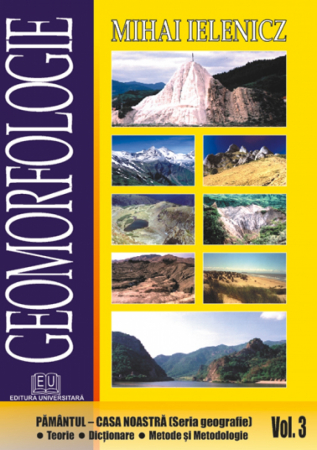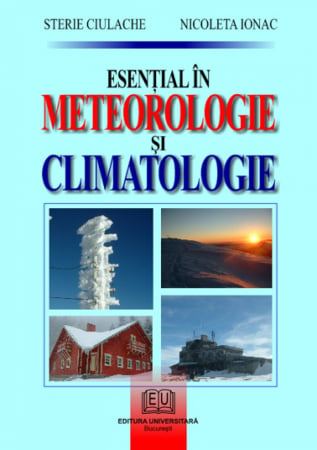Manuscript proposals: [email protected] / 0745 204 115 //// Tracking orders Individuals / Sales: 0745 200 357 / Orders Legal entities: 0721 722 783
Publisher: Editura Universitară
Author: Adrian Amadeus Tiscovschi
Edition: I
Pages: 164
Publisher year: 2022
ISBN: 978-606-28-1533-2
DOI: 10.5682/9786062815332
Product Code:
9786062815332
Do you need help?
0745 200 357
- Description
- Download (1)
- Authors
- Content
- More details
- Reviews (0)
The issue of climate risk phenomena is a topical issue, on the agenda of various domestic and international organizations, because they are responsible for major disasters, resulting in human casualties, material damage and important environmental changes. The effects of climate change are increasingly visible in Romania and internationally, whether it is intense heat waves, droughts that destroy agricultural production, floods or threats to biodiversity caused by wildfires. Global warming is driving numerous changes in different regions of the world that include increasing the frequency and severity of storms, hurricanes, floods, landslides, extreme heat or cold waves, droughts, water shortages, forest fires and other disasters. Also, the increase in temperature causes processes with a slow onset, such as sea level rise, coastal erosion, salinization, gradual change in the precipitation regime, thawing of permafrost, shrinking of the ice cap and mountain glaciers.
Probably, in the near future, the regions of Europe will increasingly face the various effects of climate change, this is because, approx. 7% of the population of the European Union lives in areas at risk of flooding, and approximately 9% is found in regions where the precipitation deficit is significant. The combined impact of climate change will pose great problems, in general, regarding the quality of life of the citizens of the European Union, generating at the same time a series of concrete challenges at the sectoral level. The dangers resulting from the increasing intensity and frequency of extreme climatic phenomena at global and national level, such as abnormally abundant precipitation in short intervals, prolonged droughts, desertification, environmental degradation, sea level rise or tropical and extratropical cyclones, already determine , on average, over 20 million people to leave their homes, and move to other areas of their countries, every year.
The European Union and the EU member states, including Romania, made a firm commitment, ratifying the Paris Agreement on climate change. This commitment translates into the EU's ambition to become the first climate-neutral economy and society, until in 2050, with an intermediate objective of reducing emissions at European level, by at least 55% compared to the level from 1990 to 2030. To translate this ambition into reality, a deep transformation is needed, which must be efficient from an economic point of view, i.e. from the point of view of costs and benefits, but also fair from a social point of view. Thus, it is possible to ensure a better efficiency of the efforts made by the international community, and by each individual country, in order to reduce the unfavorable consequences of the climatic risk phenomena.
Author
Probably, in the near future, the regions of Europe will increasingly face the various effects of climate change, this is because, approx. 7% of the population of the European Union lives in areas at risk of flooding, and approximately 9% is found in regions where the precipitation deficit is significant. The combined impact of climate change will pose great problems, in general, regarding the quality of life of the citizens of the European Union, generating at the same time a series of concrete challenges at the sectoral level. The dangers resulting from the increasing intensity and frequency of extreme climatic phenomena at global and national level, such as abnormally abundant precipitation in short intervals, prolonged droughts, desertification, environmental degradation, sea level rise or tropical and extratropical cyclones, already determine , on average, over 20 million people to leave their homes, and move to other areas of their countries, every year.
The European Union and the EU member states, including Romania, made a firm commitment, ratifying the Paris Agreement on climate change. This commitment translates into the EU's ambition to become the first climate-neutral economy and society, until in 2050, with an intermediate objective of reducing emissions at European level, by at least 55% compared to the level from 1990 to 2030. To translate this ambition into reality, a deep transformation is needed, which must be efficient from an economic point of view, i.e. from the point of view of costs and benefits, but also fair from a social point of view. Thus, it is possible to ensure a better efficiency of the efforts made by the international community, and by each individual country, in order to reduce the unfavorable consequences of the climatic risk phenomena.
Author
-
Risk climatic phenomena
Download
ADRIAN AMADEUS TISCOVSCHI
Preface / 7
Problems, terminology and classifications / 9
Chapter I. Short-term risk climatic phenomena / 16
1.1. Tornadoes / 16
1.2. Electric discharges (thunderstorms) / 30
1.3. Hail falls / 42
1.4. Solid deposits / 51
1.4.1 Frost / 51
1.4.2 Chiciura / 53
1.4.3 Poleiul / 54
1.5. Snow avalanches / 55
Chapter II. Medium-term risk climatic phenomena / 59
2.1. Fog / 59
2.2. Tropical and extratropical cyclones / 63
2.3. The blizzard / 83
2.4. Dust and sand storms / 90
2.5. Waves of heat and cold / 92
2.6. Temperature inversions / 99
Chapter III. Climatic phenomena of long-term risk / 103
3.1. Droughts / 103
3.2. Periods of excess rainfall / 106
Chapter IV. Climatic phenomena of very long duration risk / 110
4.1. The functioning of the climate system / 111
4.2. Climate variability / 115
4.2.1. Paleoclimatul / 115
4.2.2. External and internal causes of climate variability / 119
4.3. Climatic trends observed in Romania / 124
4.4. The impact of climate change / 126
4.4.1. The impact of climate change on public health / 127
4.4.2. The impact of climate change on water resources / 129
4.4.3. The impact of climate change on agricultural productivity / 130
4.4.4. The impact of climate change on tourism / 134
4.5. Implementation of measures against the effects of climate change / 137
Terminology used in the issue of climate risk phenomena / 139
Bibliography / 159
Problems, terminology and classifications / 9
Chapter I. Short-term risk climatic phenomena / 16
1.1. Tornadoes / 16
1.2. Electric discharges (thunderstorms) / 30
1.3. Hail falls / 42
1.4. Solid deposits / 51
1.4.1 Frost / 51
1.4.2 Chiciura / 53
1.4.3 Poleiul / 54
1.5. Snow avalanches / 55
Chapter II. Medium-term risk climatic phenomena / 59
2.1. Fog / 59
2.2. Tropical and extratropical cyclones / 63
2.3. The blizzard / 83
2.4. Dust and sand storms / 90
2.5. Waves of heat and cold / 92
2.6. Temperature inversions / 99
Chapter III. Climatic phenomena of long-term risk / 103
3.1. Droughts / 103
3.2. Periods of excess rainfall / 106
Chapter IV. Climatic phenomena of very long duration risk / 110
4.1. The functioning of the climate system / 111
4.2. Climate variability / 115
4.2.1. Paleoclimatul / 115
4.2.2. External and internal causes of climate variability / 119
4.3. Climatic trends observed in Romania / 124
4.4. The impact of climate change / 126
4.4.1. The impact of climate change on public health / 127
4.4.2. The impact of climate change on water resources / 129
4.4.3. The impact of climate change on agricultural productivity / 130
4.4.4. The impact of climate change on tourism / 134
4.5. Implementation of measures against the effects of climate change / 137
Terminology used in the issue of climate risk phenomena / 139
Bibliography / 159
I tried to write a book from the notes of some courses, which I have been giving for some time, at the Faculty of Geography, with the idea of a book useful not only to students who specialize in meteorology and climatology, but to all those who work in the field of Earth sciences . In the preface to the book Climate Physics, the well-known professors Jose Peixoto and Abraham Oort compared writing a book to creating a work of art, such as a sculpture. Working for several years on this book, I understood how much truth there is in what the two said. The existence of such a discipline (risk climate phenomena) in the educational plans of faculties with a geographical profile appeared together with the need to understand the functionality of the climate system, the way in which the duration and intensity of climate risks can lead to considerable human and material damage. The main purpose of this discipline is to provide students with knowledge that will allow them to understand risk phenomena, their causes, their spatio-temporal distribution, the effects on the environment, including on human society, as well as the possibilities of forecasting and combating negative effects of natural disasters. The present book is intended to be a modest contribution to the realization of these desires.
The change in climate conditions on a global scale represents a major problem, concerning for many governmental or non-governmental bodies, because a possible change in the climate will have major repercussions on very varied areas of life and socio-economic activity, practically on the entire terrestrial geographical environment . We assume that the benefits of our industrial and agricultural activities will outweigh the possible negative consequences of an unfortunate by-product of these activities, namely the increase in the concentration of greenhouse gases in the atmosphere, which could lead to global climate changes, associated with global warming. Some specialists warn us that our assumptions are far too optimistic, others assure us that the risk of global warming is so remote that the result will certainly be in our favor. We have reached a worrying impasse, because the matter is of vital importance to each of us. Climate variability and change are already influencing ecosystems and human systems. It is expected that in the future, the climatic influence on the frequency and intensity of natural hazards (floods, heat waves, droughts, forest fires, etc.) will increase, thus affecting the dynamics and services of ecosystems, people's lives and their material goods. In this context, the socio-economic and environmental consequences of disasters related to natural hazards are becoming more and more serious. The change in the spatial and temporal patterns of natural hazards requires adaptation strategies and appropriate and customized actions. Adaptation to climate change involves both anticipating the negative effects and taking appropriate measures to prevent and minimize the damage they may cause, as well as taking advantage of the opportunities that may arise. The long-term evolution of the weather from one day to the next and from one region to another describes the climate. In turn, the global climate change signal is projected at regional and local scales very differently. The current debates taking place in the international scientific community focus not so much on the existence of this signal, but rather on the uncertainties regarding its magnitude and regional projections.
Extreme weather events, considered individually, cannot be directly related to climate change (weather and climate being distinct concepts). However, viewed against the background of the observations of the last century, the events of recent decades are part of a tendency to accentuate the extreme character of some of the risk climate phenomena, a tendency highlighted both by the results of numerical experiments, in the conditions of the increase in the atmospheric concentration of gases with the effect of greenhouse, as well as the observations recorded in many regions of the globe. The increase in global average air temperature is accompanied by an increase in the frequency of heat waves in many continental regions, with droughts becoming more frequent and more intense. At the same time, the water cycle modified by climate change increases the frequency of episodes with increasingly abundant precipitation, over limited areas and for short durations, which causes more and more rapid floods. In tropical areas, the intensity of hurricanes seems to increase with the increase in surface ocean water temperature, and in the arctic area the surface covered by sea ice decreases at an accelerated rate, with consequences on the global transport of energy in the geosystem.
Without pretending to have covered the particularly complex topics related to climate risk phenomena, I hope that this book will be a useful tool for students, in the effort to understand the complexity of the climate system, that is, the system made up of the atmosphere, hydrosphere, lithosphere and biosphere, which, under the influence of incident solar radiation, determines the formation of the Earth's various climates.
The change in climate conditions on a global scale represents a major problem, concerning for many governmental or non-governmental bodies, because a possible change in the climate will have major repercussions on very varied areas of life and socio-economic activity, practically on the entire terrestrial geographical environment . We assume that the benefits of our industrial and agricultural activities will outweigh the possible negative consequences of an unfortunate by-product of these activities, namely the increase in the concentration of greenhouse gases in the atmosphere, which could lead to global climate changes, associated with global warming. Some specialists warn us that our assumptions are far too optimistic, others assure us that the risk of global warming is so remote that the result will certainly be in our favor. We have reached a worrying impasse, because the matter is of vital importance to each of us. Climate variability and change are already influencing ecosystems and human systems. It is expected that in the future, the climatic influence on the frequency and intensity of natural hazards (floods, heat waves, droughts, forest fires, etc.) will increase, thus affecting the dynamics and services of ecosystems, people's lives and their material goods. In this context, the socio-economic and environmental consequences of disasters related to natural hazards are becoming more and more serious. The change in the spatial and temporal patterns of natural hazards requires adaptation strategies and appropriate and customized actions. Adaptation to climate change involves both anticipating the negative effects and taking appropriate measures to prevent and minimize the damage they may cause, as well as taking advantage of the opportunities that may arise. The long-term evolution of the weather from one day to the next and from one region to another describes the climate. In turn, the global climate change signal is projected at regional and local scales very differently. The current debates taking place in the international scientific community focus not so much on the existence of this signal, but rather on the uncertainties regarding its magnitude and regional projections.
Extreme weather events, considered individually, cannot be directly related to climate change (weather and climate being distinct concepts). However, viewed against the background of the observations of the last century, the events of recent decades are part of a tendency to accentuate the extreme character of some of the risk climate phenomena, a tendency highlighted both by the results of numerical experiments, in the conditions of the increase in the atmospheric concentration of gases with the effect of greenhouse, as well as the observations recorded in many regions of the globe. The increase in global average air temperature is accompanied by an increase in the frequency of heat waves in many continental regions, with droughts becoming more frequent and more intense. At the same time, the water cycle modified by climate change increases the frequency of episodes with increasingly abundant precipitation, over limited areas and for short durations, which causes more and more rapid floods. In tropical areas, the intensity of hurricanes seems to increase with the increase in surface ocean water temperature, and in the arctic area the surface covered by sea ice decreases at an accelerated rate, with consequences on the global transport of energy in the geosystem.
Without pretending to have covered the particularly complex topics related to climate risk phenomena, I hope that this book will be a useful tool for students, in the effort to understand the complexity of the climate system, that is, the system made up of the atmosphere, hydrosphere, lithosphere and biosphere, which, under the influence of incident solar radiation, determines the formation of the Earth's various climates.
If you want to express your opinion about this product you can add a review.
write a review

6359.png)
![Risk climatic phenomena - Adrian Amadeus Tiscovschi [1] Risk climatic phenomena - Adrian Amadeus Tiscovschi [1]](https://gomagcdn.ro/domains/editurauniversitara.ro/files/product/large/fenomene-climatice-de-risc-218942.jpg)













